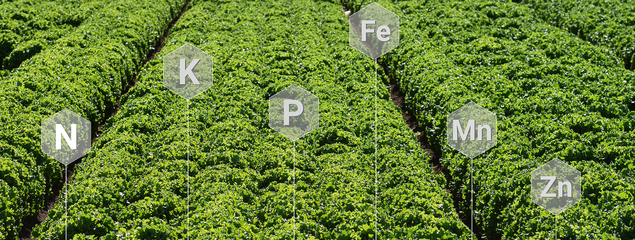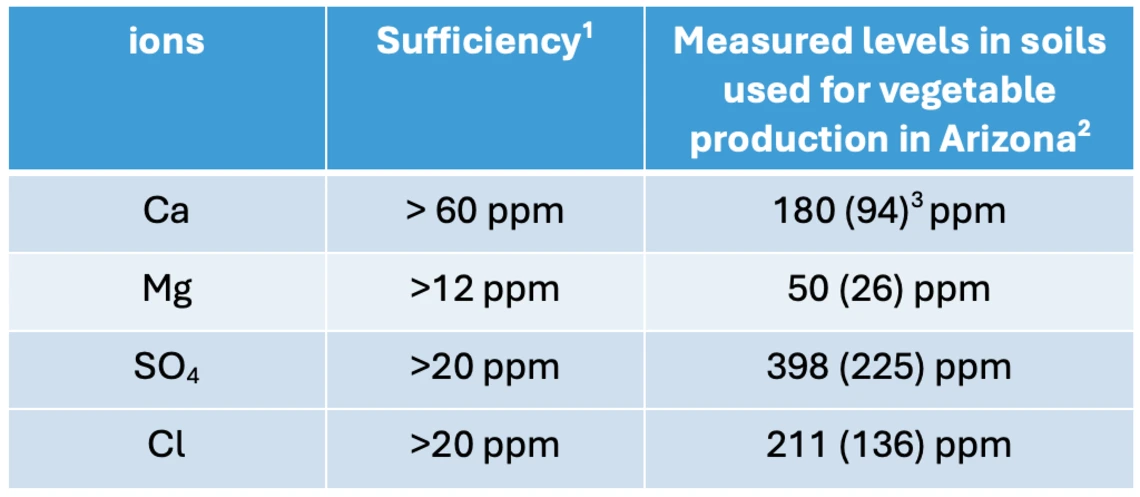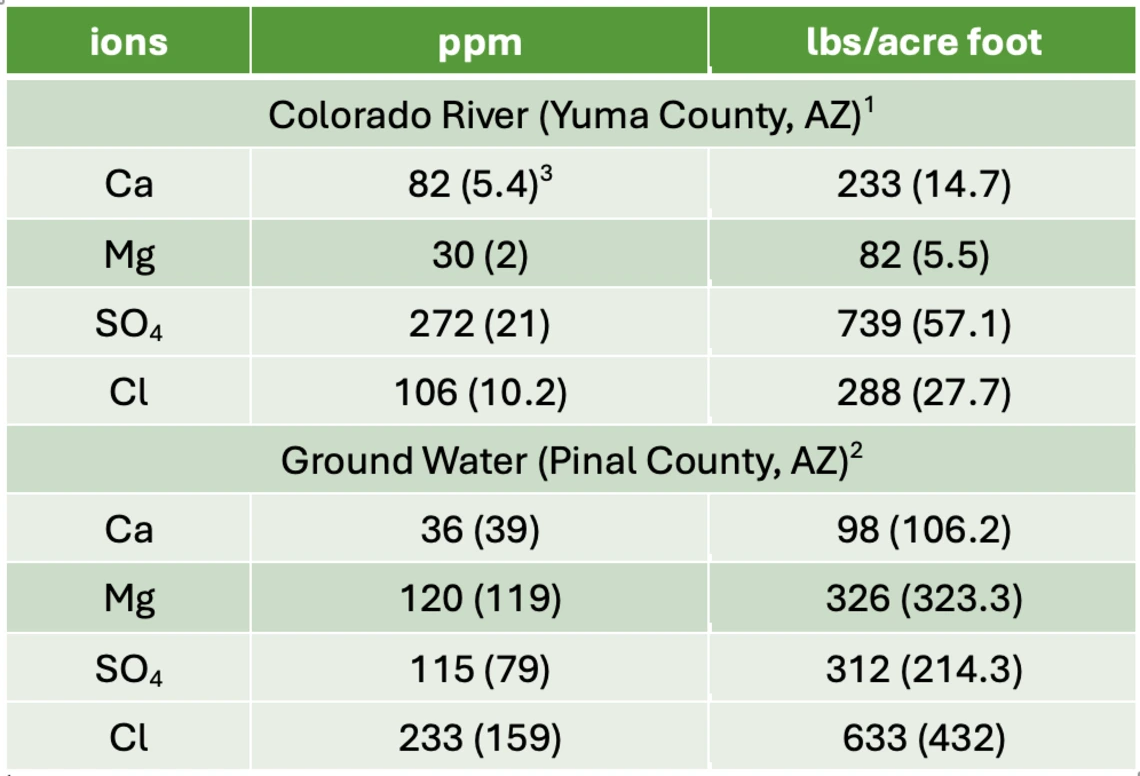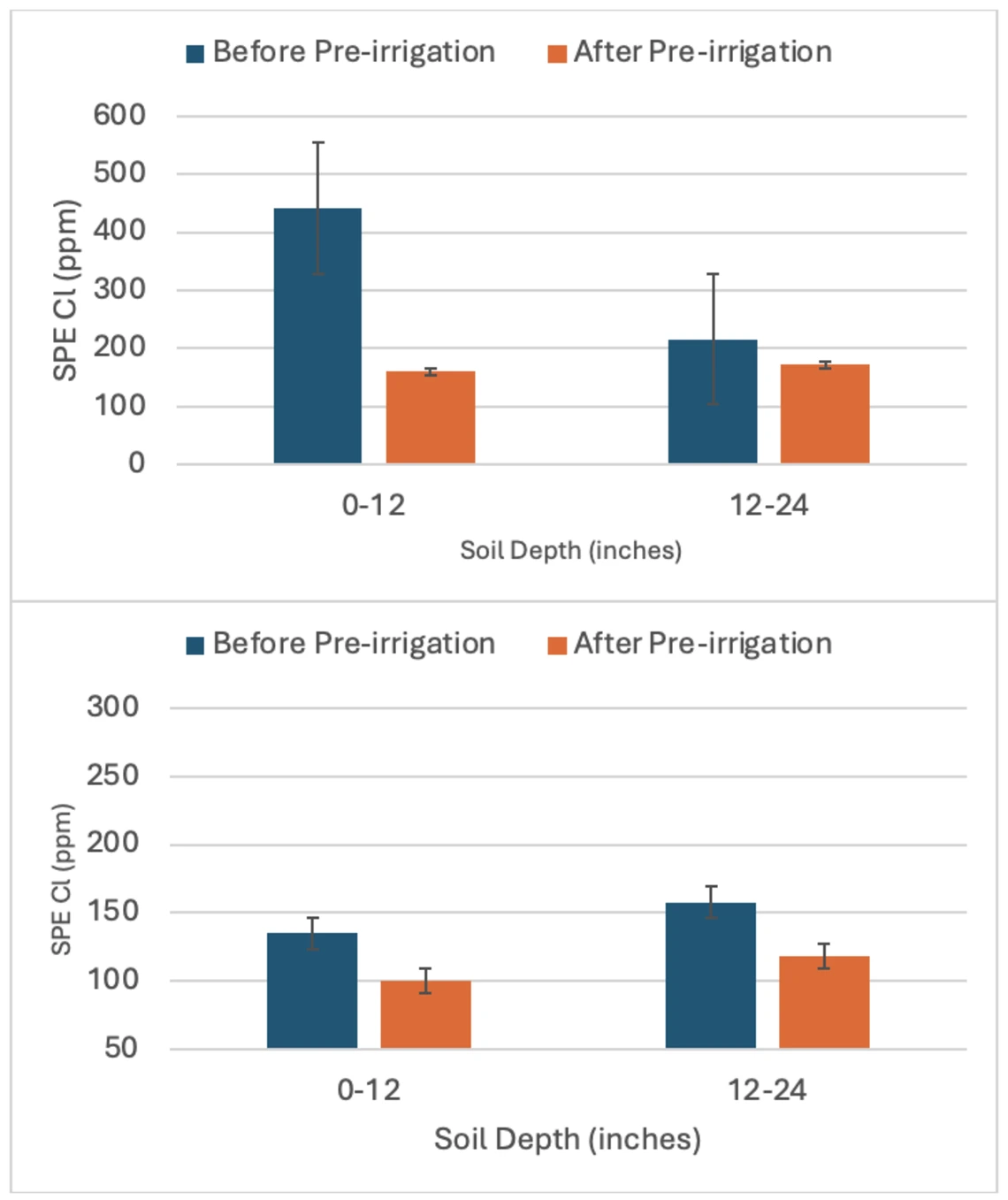
Improve Plant Nutrition
Fertilizer Guidelines for Vegetable Crops in Arizona
Nutrients Required (2)
Other Macronutrients (2.4)
Calcium (Ca), magnesium (Mg), and sulfur (S) are abundant in the agricultural systems of the Colorado River Region and other areas of Arizona. Thus, crop nutritional needs are met through natural occurrences of these nutrients and no fertilization is needed. In addition to existing elevated levels in the soil (Table 2-4-1), these nutrients are continually added through the irrigation water sources in the region (Table 2-4-2). Low Ca/Mg ratios may result in Ca deficiencies in plants regardless of Ca levels (60), which might be an issue if Ca/Mg is less than 0.5 (61). If the ratio is less than two, soil structure may become an issue because Ca is a superior flocculator to Mg. It is recommended that in systems high in bicarbonate, such as the Lower Colorado River Region, adjusted Ca values like those used in adjusted sodium adsorption ratio (SAR) calculations (62) be used in Ca/Mg interpretation (61). Regardless of the calculation method used, irrigation with water from the Colorado River results in acceptable Ca/Mg ratios. However, some ground water sources used for irrigation in Arizona do not. The challenges with sodium (Na) from some ground water sources are discussed in section 2-3, and negative impacts on soil structure are further aggravated by low Ca/Mg ratios. These conditions may require irrigation water treatments and/or soil amendments for sustained productivity. It should be noted that Ca and S products are occasionally applied as soil amendments in Arizona (59) but not for direct nutritional purposes.
Chloride (Cl) is considered an essential micronutrient due to the small amounts required for its role in photosynthesis and the regulation of some enzymes (63). It was assumed that the macronutrient magnitudes of accumulation by plants were the result of passive uptake and/or the appropriation of nitrate transporters due to the large ubiquities presence of Cl in many natural systems. More recently, reports of crops responses to Cl fertilization and reports of positive physiological benefits associated macronutrient levels of plant accumulation have prompted some to designate Cl a beneficial macronutrient (63) in addition to being an essential micronutrient. The inclusion of Cl in this section is less an endorsement of this position as it is a practical consideration that Cl is present in our soil and water systems in similar magnitudes as the other ions in this section, contributes to overall soil salinity in addition to being a required nutrient, and is assessed using the same soil test methodology.
Crops have been shown to respond positively to Cl fertilizers when soil test levels are less than 20 ppm by saturated paste extracts (SPE) (64). Background levels of Cl in the Lower Colorado River Region are an order of magnitude higher than this (Tables 2-4-1 and 2-4-2) and the main concern in this region remains potential Cl toxicity. Most vegetable crops in the region are classified as sensitive to very sensitive to Cl, and SPE levels greater than 355 ppm pose risks (65). Like other salinity ions, soil solution levels are concentrated by evapotranspiration, and levels sometimes exceed this upper threshold. Employing the recommended leaching requirement for general salinity management in the region (66, 67) maintains SPE Cl levels below this threshold (9) (Figure 2-4-1). Another concern with Cl is potential leaf burn to overhead irrigation by sprinklers. Crops vary in sensitivity to leaf burn and crop specific threshold values for overhead irrigation water can be found at (68). The Cl content for Colorado River water remains below problematic thresholds for overhead irrigation for all crops grown in the region. However, some ground water sources exceed tolerance levels for many crop species.

Table 2-4-1
Levels of Ca, Mg, and SO4 found in saturated paste extracts (SPE) from soils used for vegetable production in Arizona compared to minimum levels of sufficiency.
1Data derived from (61, 64, 69). Levels in water and SPE are often reported in meq/L rather than ppm (mg/L). The conversion to milliequivalents requires division of values for ppm by equivalent weight. To get meq/L from ppm divide values for Ca by 20, Mg by 12.2, SO4 by 48, and Cl by 35.5.
2Data from 740 samples collected in 2016-2022 across the Yuma vegetable production region including the Bard Water District, Yuma County Water Users Association, Yuma Irrigation District, North Gila Irrigation and Drainage District, and the Wellton-Mohawk Irrigation and Drainage District. Adapted from (14).
3Values in parenthesis are standard deviation.

Table 2-4-2
Macronutrient concentrations in irrigation water sources
1Data is mean of 549 water samples collected over time at the Imperial Diversion Dam. The conversion to milliequivalents requires division of values for ppm by equivalent weight. To get meq/L from ppm divide values in mg/L for Ca by 20, Mg by 12.2, SO4 by 48, and Cl by 35.5.
2Data is mean of 40 irrigation wells sampled in Central Arizona.
3Values in parenthesis are standard deviation.

Figure 2-4-1
Reduction in Cl values in saturated past extracts (SPE) to pre-irrigation prior to vegetable season in sites in the Yuma Irrigation District and Wellton-Mohawk Irrigation and Drainage District. A pre-irrigation is typically performed to restore salt balance prior to production of salt sensitive vegetable crops.

